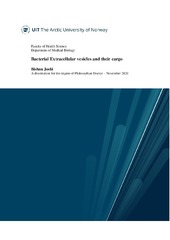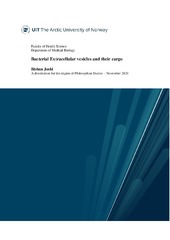| dc.contributor.advisor | Johannessen, Mona | |
| dc.contributor.author | Joshi, Bishnu | |
| dc.date.accessioned | 2021-01-04T14:13:17Z | |
| dc.date.available | 2021-01-04T14:13:17Z | |
| dc.date.issued | 2021-02-05 | |
| dc.description.abstract | <i>Staphylococcus aureus</i> and <i>Enterococcus faecium</i> are opportunistic pathogens that may cause diseases ranging from minor skin infection to severe blood stream infections. The emergence of methicillin-resistant <i>Staphylococcus aureus</i> (MRSA) and vancomycin-resistant enterococcal strains severely limits treatment options. Bacteria release extracellular vesicles (EVs), defined as “particles naturally released from the cell that are delimited by a lipid bilayer and cannot replicate”. They are packaged with an array of virulence factors, resistant determinants, and nucleic acids and participate in host-microbe and microbe-microbe interactions. EVs might be used for therapeutic applications e.g., carriers for drug delivery, vaccine, and diagnostic biomarkers. The characterization of EV cargo is limited in Gram-positive bacteria. Given the importance of EVs, this thesis aimed to examine proteome and transcriptome of these nanoparticles upon bacterial exposure to various growth conditions. Using a label-free proteomic approach, <i>E. faecium</i> EVs proteome was profiled for the first time. We found that growth phase and growth conditions (e.g., media, sub-MIC dosage of vancomycin) influenced the proteome content. The EVs contained a wide range of different proteins including vaccine candidates, antimicrobial resistance determinants and virulence factors. The sub-inhibitory dosage of vancomycin also influenced the proteome profile of MRSA and revealed relatively increased expression of EV- associated proteins that might be involved in bacterial colonization and antibiotic resistance (e.g., multiple antibiotic resistance regulators, amino acyltransferases, and penicillin binding proteins). Intriguingly, we also demonstrated that EVs attenuated the susceptibility of MRSA to vancomycin, which is commonly used as first-line therapy in clinical practices. Transcriptomic analysis of RNA isolated from <i>S. aureus</i>-derived EVs revealed presence of various RNA biotypes including mRNA, rRNA, tRNA, and small RNA. In summary, the thesis demonstrate that several virulence factors, immunogenic proteins, and/or small RNAs were associated with the EVs isolated from <i>E. faecium</i> and <i>S. aureus</i>. | en_US |
| dc.description.doctoraltype | ph.d. | en_US |
| dc.description.popularabstract | Enterococcus faecium and Staphylococcus aureus live peacefully in specific niches of the body, but are capable of causing diseases ranging from minor skin infection to serious blood infection. The multi-drug-resistant (MDR) version of these bacteria limits the treatment options. Both bugs naturally release non-living nano-bubbles, called extracellular vesicles (EVs). EVs are filled with an array of bio-molecules such as DNA, RNA, and proteins, and might be used for the therapeutic purposes such as carriers for drug delivery, vaccine and diagnostic biomarkers. We showed for the first time that E. faecium produces EVs, and that their proteome content are affected by the bacterial growth condition. We also demonstrated that S. aureus-derived EVs carry RNAs. Furthermore, we found that EVs influenced the bacteria’s ability to tolerate vancomycin, one of the last resort antibiotics for the treatment of MDR S. aureus. These studies, in combination with future studies, hold promises for EVs in the development of vaccine and biomarkers for diagnostics and prognostic purposes. | en_US |
| dc.identifier.uri | https://hdl.handle.net/10037/20169 | |
| dc.language.iso | eng | en_US |
| dc.publisher | UiT The Arctic University of Norway | en_US |
| dc.publisher | UiT Norges arktiske universitet | en_US |
| dc.relation.haspart | <p>Paper I: Wagner, T., Joshi, B., Janice, J., Askarian, F., Škalko-Basnet, N., Hagestad, O.C., … Johannessen, M. (2018). <i>Enterococcus faecium</i> produces membrane vesicles containing virulence factors and antimicrobial resistance related proteins. <i>Journal of Proteomics, 187</i>, 28-38. Also available in Munin at <a href=https://hdl.handle.net/10037/14580>https://hdl.handle.net/10037/14580</a>.
<p>Paper II: Joshi, B., Singh, B., Nadeem, A., Askarian, F., Wai, S.N., Johannessen, M. & Hegstad, K. (2020). Transcriptome profiling of <i>Staphylococcus aureus</i> associated Extracellular Vesicles reveals presence of small RNA-cargo. (Submitted manuscript). Now published in <i>Frontiers in Molecular Biosciences, 7</i>, 566207, available at <a href=https://doi.org/10.3389/fmolb.2020.566207>https://doi.org/10.3389/fmolb.2020.566207</a>.
<p>Paper III: Kumaraswamy, M., Will, K., Joshi, B., Sakoulas, G., Kousha, A., Vaaje-Kolstad, G., … Askarian, F. Bacterial Membrane-Derived Vesicles Attenuate Vancomycin Activity against Methicillin-Resistant <i>Staphylococcus aureus</i>. (Manuscript). | en_US |
| dc.rights.accessRights | openAccess | en_US |
| dc.rights.holder | Copyright 2021 The Author(s) | |
| dc.rights.uri | https://creativecommons.org/licenses/by-nc-sa/4.0 | en_US |
| dc.rights | Attribution-NonCommercial-ShareAlike 4.0 International (CC BY-NC-SA 4.0) | en_US |
| dc.subject | VDP::Medical disciplines: 700::Health sciences: 800::Other health science disciplines: 829 | en_US |
| dc.subject | VDP::Medisinske Fag: 700::Helsefag: 800::Andre helsefag: 829 | en_US |
| dc.title | Bacterial Extracellular vesicles and their cargo | en_US |
| dc.type | Doctoral thesis | en_US |
| dc.type | Doktorgradsavhandling | en_US |


 English
English norsk
norsk

